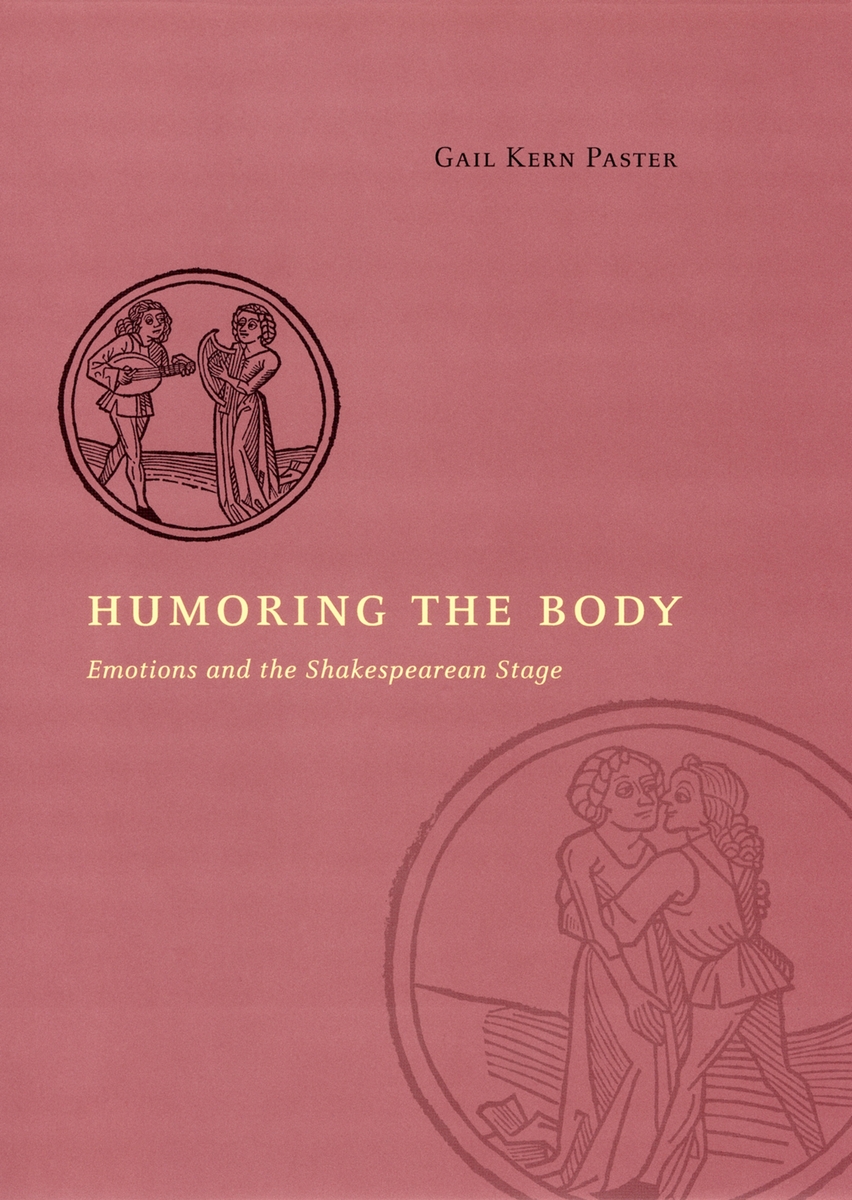Humoring the Body
Emotions and the Shakespearean Stage
University of Chicago Press, 2004
Cloth: 978-0-226-64847-7 | Paper: 978-0-226-21382-8 | Electronic: 978-0-226-64848-4
DOI: 10.7208/chicago/9780226648484.001.0001
Cloth: 978-0-226-64847-7 | Paper: 978-0-226-21382-8 | Electronic: 978-0-226-64848-4
DOI: 10.7208/chicago/9780226648484.001.0001
AVAILABLE FROM
University of Chicago Press (paper, ebook)Amazon Kindle (PDF)
Apple Books
Barnes & Noble Nook
Chegg Inc
Copia Interactive
DeGruyter Multi-User Ebook Program
ebrary
EBSCO eBooks (formerly NetLibrary)
Google Play
Kno
University Press Scholarship Online (UPSO)
ABOUT THIS BOOKAUTHOR BIOGRAPHYREVIEWSTABLE OF CONTENTS
ABOUT THIS BOOK
Though modern readers no longer believe in the four humors of Galenic naturalism—blood, choler, melancholy, and phlegm—early modern thought found in these bodily fluids key to explaining human emotions and behavior. In Humoring the Body, Gail Kern Paster proposes a new way to read the emotions of the early modern stage so that contemporary readers may recover some of the historical particularity in early modern expressions of emotional self-experience.
Using notions drawn from humoral medical theory to untangle passages from important moral treatises, medical texts, natural histories, and major plays of Shakespeare and his contemporaries, Paster identifies a historical phenomenology in the language of affect by reconciling the significance of the four humors as the language of embodied emotion. She urges modern readers to resist the influence of post-Cartesian abstraction and the disembodiment of human psychology lest they miss the body-mind connection that still existed for Shakespeare and his contemporaries and constrained them to think differently about how their emotions were embodied in a premodern world.
Using notions drawn from humoral medical theory to untangle passages from important moral treatises, medical texts, natural histories, and major plays of Shakespeare and his contemporaries, Paster identifies a historical phenomenology in the language of affect by reconciling the significance of the four humors as the language of embodied emotion. She urges modern readers to resist the influence of post-Cartesian abstraction and the disembodiment of human psychology lest they miss the body-mind connection that still existed for Shakespeare and his contemporaries and constrained them to think differently about how their emotions were embodied in a premodern world.
AUTHOR BIOGRAPHY
Gail Kern Paster is the former director of the Folger Shakespeare Library. She is the author of The Idea of the City in the Age of Shakespeare and The Body Embarrassed: Drama and the Disciplines of Shame in Early Modern England.
REVIEWS
"Humoring the Body challenges our familiar understanding of the relationship between early modern subjects and their surroundings. Paster reveals a Shakespearean landscape saturated in feeling. . . . Paster's book is lively, colourful and often very funny. Its most striking achievement is to reveal not only how Shakespeare's men and women inhabited the world, but also how the world inhabited them in return."
— Katherine Craik, Times Literary Supplement"Through a juxtaposition of Renaissance plays by Shakespeare and others, and of Renaissance juridical, medical and philosophical texts on the humors, Paster manages to bridge the wide gap between the post-Emlightenment twenty-first-century reader and the Renaissance, making it possible for him/her to perceive the ontological and phenomenological dimension of the emotional experience of the Renaissance subject."
— Cercles"A meticulously researched study that pushes readers to rethink early modern discourses of the passions from a phenomenological perspective. It provides a solid grounding in critical conversations about early modern epistemologies of embodiment, gender and subjectivity."
— Loren M. Blinde, Comitatus"A brief review cannot do justice to how Paster's local readings transform the reading of entire plays, indeed of character generally in early modern drama."
— Alberto Cacicedo, Renaissance Quarterly"Those interested in English renaissance drama will find in [Paster's] neo-humoral exploration of dramatic motivation and causation some substantial contributions to critical interpretation of the canon. . . . In her delicate excavations of English renaissance drama, Paster unearths a vast network of humoral meanings, so easy to misconsture as merely metaphorical today. She succeeds remarkably in reclaiming the inner and outer landscape of consciousness within which such characters as Hamlet, Othello and Desdemona have their being."
— William Dodd, Nuncius"[Paster] undertakes to read Shakespeare literally. This is a bold step, which has profound implications for bothcriticism and performance. Much of what she offers is revelatory."
— Ros King, MLR"Paster's excellent book brims with fascinating information about sixteenth-century concepts of the body, especially interactions of body, mind, and environment that produce emotion. Her works forms part of the larger project of excavating the early modern mental landscape."
— Linda Woodbridge, Journal of the History of Medicine and Allied Sciences"Humoring the Body is a remarkable book: probing and thick with insight, written with a deft touch and enormous peripheral vision of the world outside the plays that we find ourselves orbiting again and again. . . . An engrossing, rewarding book to read."
— Douglas Trevor, MLQ"In an engaging and fascinating work, the author succeeds in restoring 'the historical particularity of early modern emotional self-experience' in the plays of Shakespeare and others. . . . Not only has the author helped us reassess the uses of employment of the passions in early moderd drama, but she has reminded us that the daily experience of emotions in the early modern age was different from our own."
— David A. J. Widmer, Sixteenth Century JournalTABLE OF CONTENTS
List of Illustrations
Acknowledgments
A Note on Citations
Introduction - Gail Kern Paster
Roasted in Wrath and Fire - Gail Kern Paster
Love Will Have Heat - Gail Kern Paster
Melancholy Cats, Lugged Bears, and Other Passionate Animals - Gail Kern Paster
Belching Quarrels - Gail Kern Paster
Epilogue - Gail Kern Paster
Bibliography
Index
